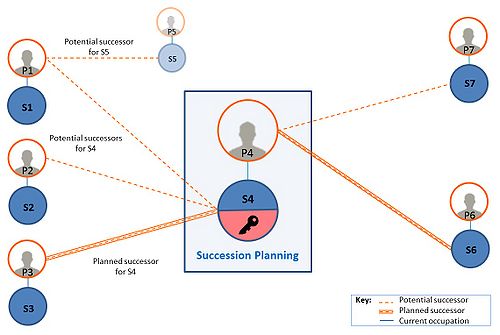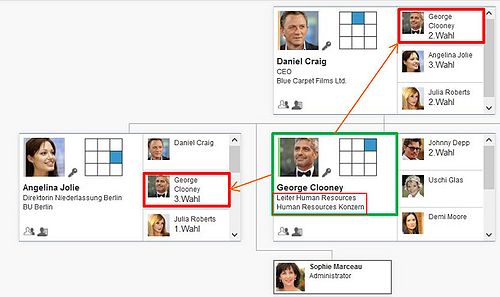Succession planning
Succession planning enables provisional plans to be made to place new people in jobs. Succession planning aims to minimize the risk of a job not being filled. Succession planning well in advance is particularly essential for jobs that have been defined as critical key positions.
Succession planning is mainly based on company objectives and (future) skills requirements. Firstly, the objectives are established and the general situation is clarified (e.g. budget restrictions), giving a basis for then planning the various measures.
Identify potential successors
After establishing the key positions for succession planning, potential successors can be assigned to each job. There are different ways to find potential successors:
- Manually assign potential successors to the job
- Use the interactive search
- Advertise the job within the company area (employees nominate themselves)
Criteria from the employee review meeting, such as development potential or risk of leaving, may also help with selections.
Using the interactive search to assign potential successors

If you want to find a potential successor using the interactive search, it is a good idea to run the search based on a function profile.
If you opt for this method, a succession function profile should first be assigned to the job. This is usually identical to the current function profile. You then choose the option “Copy search criteria for interactive search from succession function profile.” When you then run the interactive search, the criteria which are identical to the function profile are automatically selected. However, you can run the interactive search without assigning a function profile by setting the search filters manually.
![]() So, for succession planning to be reliable, it is advisable to go to Settings and select the job ID is “unique” option. Succession planning for previous positions is thereby maintained for other jobs with the same keys and can be continued. The key factor here is the combination of the job keys, or the source key in combination.
So, for succession planning to be reliable, it is advisable to go to Settings and select the job ID is “unique” option. Succession planning for previous positions is thereby maintained for other jobs with the same keys and can be continued. The key factor here is the combination of the job keys, or the source key in combination.
![]() Note the difference between competencies and skills.
Note the difference between competencies and skills.
![]() Note that, by default, some of the fields in the list that follows are hidden.
Note that, by default, some of the fields in the list that follows are hidden.
Potential and Risk
- Development potential
- Potential function area
- Potential managerial responsibility
- Potential position
- Potential user-defined list 1–7
- Risk of leaving
Potential self-assessment
- Development potential self-assessment
- Potential function area self-assessment
- Potential managerial responsibility self-assessment
- Potential position self-assessment
- Potential user-defined list self-assessment (1–7)
Professional experience
- Experience in country
- Industry experience
- Experience in position
- Experience of managerial responsibility
- Experience user-defined list 1–3
Education
- Education in country
- Area of study
- Education level
- Education user-defined list 1–3
Academic studies
- Academic studies in country
- Degree course
- Degree
- Academic studies user-defined list 1–3
Training
- Development category
- Training in country
- Training area of study
- Training qualification
- Training user-defined list 1–3
Skills and competencies
- Language skills
- General skills
- IT skills
- Technical skills
- Methods expertise
- Soft skills
- User-defined competencies list 6
- Knowledge in the field of film and television
- User-defined competencies list 8–12
- Driver's license
- Gender
Development of potential successors
If you have assigned potential successors to a job, the next step is to use various criteria, e.g. readiness, to assess and prioritize them. To help, you can compare the candidates to one another or display the suitability of a potential successor for the relevant position profile in graphic form ().
By displaying their suitability graphically and comparing them to other potential successors, your candidates can pursue goal-based development and be helped in a focused way by participating in development programs.
Towards the end of the succession planning process, i.e. when the potential successors have been assigned, the planned successor is usually named.
Succession Planning Complexity and Organigram
Succession planning can sometimes be highly complex and certain aspects should be given particular attention.
![]() Resulting Chain Reaction: When an employee is assigned to a job as a potential successor there is a chain reaction, since the employee’s current job will also have to be filled.
Resulting Chain Reaction: When an employee is assigned to a job as a potential successor there is a chain reaction, since the employee’s current job will also have to be filled.
![]() Risk of Over-planning: Since an employee can usually only occupy one job, there is a need to keep an eye on how many jobs the employee has been nominated for as a potential successor.
Risk of Over-planning: Since an employee can usually only occupy one job, there is a need to keep an eye on how many jobs the employee has been nominated for as a potential successor.
The organigram is a useful succession planning tool, for example by showing the complexity described.


| Explanation of Figure 2 |
|---|
|
Person P4 does job S4, which is a so-called key position. The succession needs to be planned for this job:
⇒ Risk of chain reaction: P4 takes on new job S6, P3 moves over to empty job S4, so the succession needs to be planned for S3! ⇒ Risk of over-planning: P1 has been named as a potential successor for both S5 and S4. But, ultimately, they can only do one job. |
| Explanation of Figure 3 |
|---|
|
⇒ Risk of chain reaction: George Clooney has been named as the successor to Daniel Craig, i.e. a succession plan is required for Clooney’s current job. ⇒ Risk of over-planning: George Clooney is a potential successor both for the “Berlin Branch Manager” job and the “London Branch Manager” job. Ultimately, though, he can only do one job. |
Who sees what here?
URL: /Positions/All/1/Succession
What people see here:
- Administrator -> Can see and select everyone as potential successors.
- HR expert -> Can see external individuals, direct subordinate employees and the direct subordinate employees of direct subordinate individuals
- Managing Director -> Can see external individuals, direct subordinate employees and their direct subordinate individuals
- Manager with access to direct subordinates -> Can see external individuals, direct subordinate employees and their direct subordinate individuals
- Manager with access to direct subordinates and other organizational units -> Can see external individuals, direct subordinate employees and their direct subordinate individuals plus those individuals who the manager can access via the assigned organizational units.
![]() So the role assignment and access permissions to the organizational units are crucial for succession planning permissions.
So the role assignment and access permissions to the organizational units are crucial for succession planning permissions.